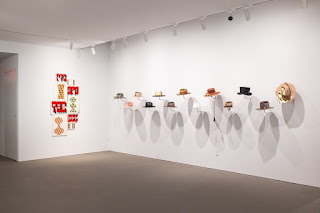Bright orange shelves beckon me to discover their treasures. Pieces of coral, seed pods, and plastic bottles, stacked, adorned, and bound together with netting or string, are placed on crocheted doilies. Veronica Ryan’s works are evidence of a process of collection and ordering, a curiosity cabinet filled with fragments of her experience as a woman born in Montserrat and raised in England.
Nearby, hundreds of egg crates are stacked and connected by crocheted tunnels cut into them. One wall is lined with remnants of pipes, drains, and other plumbing components, closed up with cement or clogged with hair.
These seemingly everyday objects, robbed of their function through Ryan’s interventions, convey a sense of displacement, and a yearning for home or a sense of belonging.
The slightly cluttered arrangements, which evoke knick knacks on shelves in someone’s home, make it harder for viewers to find a place of contemplation. Yet, the show raises much larger issues of European colonization and its lasting effect on the peoples, cultures, and economies of the Caribbean, as well as the volcanic eruption in 1995 which forced many residents of Montserrat to evacuate permanently.







